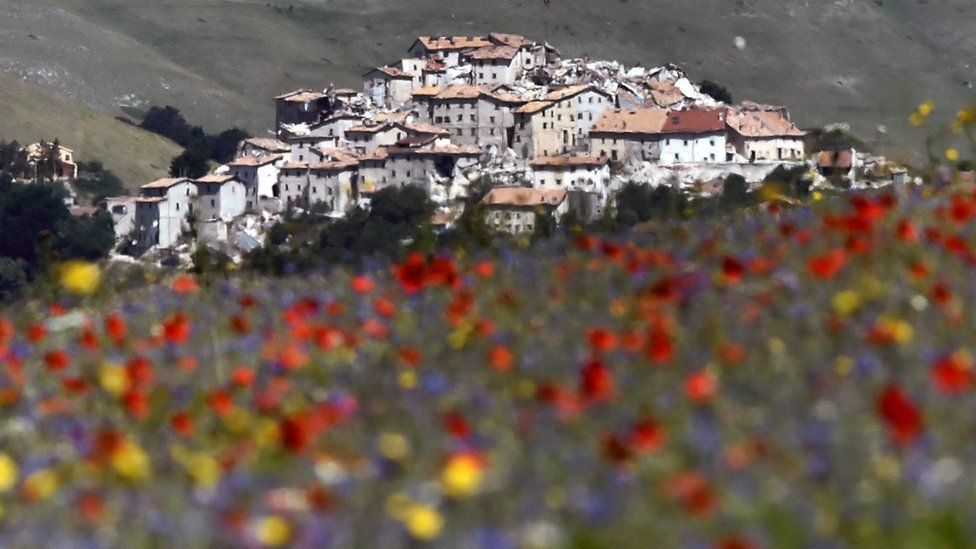Italian tourist treasure turned into ghost town by earthquake
- Published

From a distance Castelluccio looks the same as it has done for 1,000 years, a beautiful hilltop town in the midst of one of Italy's most celebrated plains, the Piano Grande.
But even from the road below the village you can see the buildings are shattered, roofs collapsed, more reminiscent of a war zone than the Umbrian countryside.
Nearly a year on from the earthquakes which devastated this region of central Italy, visitors have just been allowed back into the so-called "zona rossa" near Castellucio, although not the village itself.
The red zone marks areas still regarded as too dangerous to visit but an exception was made for people to see "La Fioritura". This is a spectacular showing of wild flowers in the meadows of the Piano Grande.
We joined a convoy of around 40 cars to be taken through army road blocks high up into the Sibillini mountains.
Village after village showed the impact of the earthquakes that hit this region, first in August 2016 and then again in October.
These villages look as if the earthquake had just happened, instead of nearly a year ago. Most of the people who lived there have been moved to hotels on the coast.
We left our cars on top of a high ridge and trekked for two hours down on to the plain, overlooked by the jagged peak of Monte Vettore, which marks the boundary between Umbria and Le Marche.
A deep, black crack could be seen high up on the mountainside which had appeared after the earthquake.
As we came down on to the plain, extraordinary splashes of colour came into view, reminiscent of an Impressionist canvas.
Meadows were tinted red with swathes of poppies, others bright blue with cornflowers. Normally there would be 10,000 visitors a day to photograph the splendours of the Fioritura, we were told. This year it is in the hundreds.
There are more beehives than people in the fields.
The 16 sq km (6 sq miles) Piano Grande - literally the big plain - was once a glacier lake and is surrounded by mountains.
It is here that the farmers of Castelluccio plant their lentils, a crop that has become famous amongst foodies around the world.
This year they were only allowed in by convoy to prepare for the season ahead. No-one is allowed up into this ghost village at 1,452m (4,760 ft).
Below what has been his home for generations, Lorenzo Caponecchi is selling lentils and wild peas in a stall by the side of the road.
I wondered why it was taking time for rebuilding to begin. Was it because these were such old buildings or was it a question of money?
No, said his partner Monia Falzetti angrily. "It's the state and the politicians. There is plenty of money from the EU but we aren't seeing any of it."
Other former inhabitants of Castelluccio are so angry at the lack of help that they believe visitors should not be allowed into the Piano Grande.
It is the tourism of rubble, they proclaim.
But the local mayor told La Repubblica that the flowers of the Piano Grande do not just belong to the people of Castelluccio. They are the world's heritage and, besides, more tourism will help the local economy.
Side by side in this unique valley, you can see the sublime beauty of nature at its most spectacular but also the forces of nature at its most destructive.
In a few moments here houses that existed for hundreds of years were torn down and reverted to stones.
- Published30 October 2016